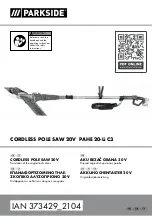
Page 9
For technical questions, please call 1-800-444-3353.
SKU 68819
You may need to use saw horses or other supports
(not included) to support the work piece. If the work
piece is not level, you will make an unintentional
bevel cut in the material. If the work piece is not
supported, it will bind the blade and may cause the
material to kick back, potentially causing injury.
adjusting the Miter angle
1. A miter cut is one that is at an angle across
the horizontal surface of the material. You will
commonly make 45º miter cuts to join two pieces
in a right angle corner. A 30º cut is often used
for a scarf joint or to make a chamfered end.
2. To make a miter cut, loosen the
Miter Position Handle.
3. Depress the Miter Lock Tab to move the Table to
the desired angle. The Miter Angle Indicator will
indicate the selected angle. The table will click into
place at often used miter angles, including 22.5º,
30º, 45º, and 90º on both left and right sides.
4. Tighten in place with the Miter Position Handle.
5. With the Table adjusted to the desired angle, place
the work piece flush against the Fence, secure
it with the Hold Down Vise and make the cut.
adjusting the bevel angle
1. A bevel cut is one that is at an angle to
the vertical plane of the material.
2. Bevel cuts can be used to miter relatively wide
and thin material. Bevel cuts can be used in
combination with a miter cut to form a compound
angle. Compound angle cuts are often used in
crown, picture frames and similar trim materials.
3. To set the bevel angle, loosen the Bevel Lock
Handle at the rear of the saw. Move the blade
assembly to the desired angle. Read the angle
on the Bevel Angle Indicator. Lock the blade
assembly into position by tightening the Bevel
Lock Handle. Tighten firmly but not over‑tight.
4. Make a sample cut in a piece of scrap and check
to be sure the bevel angle is correct. If it is not,
correct the angle before cutting your work material.
using the Depth Stop
1. To make a kerfing or rabbet cut which does not
cut through the work piece, you can engage the
Depth Stop Bolt to control the depth of the cut.
2. To limit blade assembly travel, turn the Depth Stop
Bolt (64) clockwise. The further you screw down
the Depth Stop Bolt, the shallower the cut will be.
3. After the desired cut has been made, return
the Depth Stop Bolt to it’s original position.
note:
This saw is not designed to be used with
a true Dado blade. To make wide Dado cuts you
will need to make multiple adjacent passes of
the blade to achieve the desired cut width.
Making a Cut
Observe all safety and planning items discussed
in this booklet. Detailed instructions on each of the
following steps are discussed in this booklet. Do not
make any cuts until you have read this entire booklet
and are familiar with the operation of this tool.
note:
Before making a cut, check that the Hold
Down Vise will not be in the path of the cut. Move
the Vise to the other side of the Fence if needed.
1. Pull down on the blade assembly slightly and
release the Lock Pin to allow the blade assembly
to come up. Check to be sure the Table is
fixed in place at the desired miter angle.
2. Blow any sawdust or debris away from the Fence.
Place the work material against the Fence.
3. Make any necessary miter or bevel adjustments.
4. Turn the Laser guide on, using the
switch on the back of the unit.
5. Align the marked location of the cut on the work
material with the saw blade. Be aware that the Saw
Blade will remove material from the cut equal to
the width of the blade. This is the “kerf”. To prevent
your work piece from being cut too short, align
the edge of the blade with your measured mark,
keeping the kerf on the waste side of the cut.
6. Hold the work material in place using the
Hold Down Vise. Ensure that the work
material is level and supported securely, using
saw horses or supports if necessary.
7. Grip the Saw Handle, squeeze the
Trigger to start the Blade turning.
8. Allow the Blade to come to full speed.
9. Pressing down lightly, move the Blade smoothly
across the work material to cut it. Press straight
down, “chopping” the material. Do not bear down
on the material, use light downward pressure. If
the material binds the blade, release the trigger.
Keep your hands away from the Blade.
10. When the cut is completed, release the Trigger
and raise the blade assembly. Wait for the Blade
to stop turning, release the Hold Down Vise
and remove the work material from the saw.
11.
the laser guide will not turn off automatically.
turn the laser guide off using the switch on the
side of the laser battery housing.
This is important
to prevent accidental eye exposure to the laser beam.


































